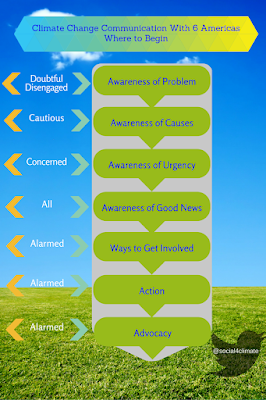Climate change is a complex topic that needs to be understood by the public. This is important now more than ever as climate change is bound to become a major issue in the upcoming national elections, and as the President prepares to defend his Climate Change Action Plan against special interests and their allies in Congress. But with so many moving parts that define earth's climate, where do you begin communicating with the public about climate change? Like any effective communication endeavor, the answer lies in customizing the message to the audience. Thanks to outstanding data from Yale Project on Climate Change Communication (YPCC), based on excellent work done by Anthony Leiserowitz and colleagues, we know there is a spectrum of knowledge and attitudes towards climate change in the United States. This spectrum consists of 6 distinguishable groups of the American public, referred to as "The 6 Americas". I attempt to outline them below:
- Dismissive: Most certain that global warming is not happening, or even if it is happening, they do not view human activity as an underlying cause. They are quite engaged in the topic and consider themselves well informed. They do not view global warming as a threat for current or future generations.
- Doubtful: Similar to the Cautious segment (see below) in terms of their level of knowledge about climate change. However, they tend to believe global warming is not much of a threat to people in general. The are more likely to say that global warming is caused by natural changes in the environment
- Disengaged: Least knowledge and interest in climate change
- Cautious: Somewhat knowledgeable about climate change, and view it as a distant threat. A large proportion believe that science around causes of climate change is not settled or that global warming is due to natural causes
- Concerned: Knowledgeable and concerned about global warming due to human activity, however they do not view it as something that is happening now or effecting them personally. They are not as active as the Alarmed in climate change mitigation efforts, but show an interest to do more.
- Alarmed: Most knowledgeable and convinced about immediacy and causes behind climate change, and they are most vocal and active about climate change mitigation
Despite the range of differences in attitude and knowledge about human-caused climate change, one thing remains similar among all these groups: A lack of optimism about whether humans can or will take action to reduce global warming. Obviously, a message of optimism and faith in our power to mitigate global warming is something all segments of the American population need to hear.
Aside from communicating a message of hope, each of the 6 segments of the American public require a unique approach depending on where their knowledge gaps and attitudes lie. Learning from the data published by YPCC, I have aimed to match 7 communication starting points with the 6 Americas market segments. Each of these starting points are defined below and visually represented in the infograph at the end of this post:
- Awareness of Problem: Communicating that global warming is a real threat
- Awareness of Causes: Communicating that humans are causing global warming
- Awareness of Urgency: Communicating that global warming is affecting us right now, today
- Awareness of Good News: Communicating all the positive outcomes from efforts towards mitigating climate change
- Ways to get involved: Communicating different ways everyone can get involved in mitigating climate change
- Action: Communicating the stories of and acknowledging those who are taking action
- Advocacy: Communicating ways in which action takers can encourage their communities to join the effort
Where do you feel climate change communication needs to begin? Do you have any suggestions for improving this climate change communication infograph? I would love to hear your thoughts!

